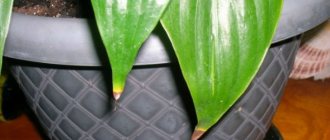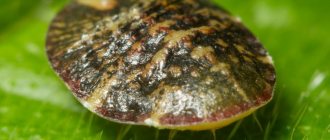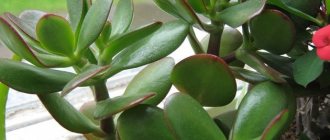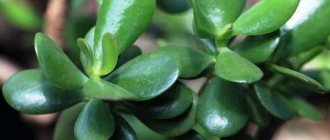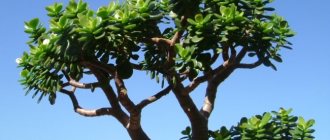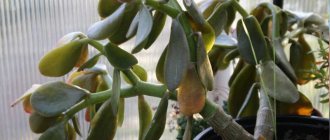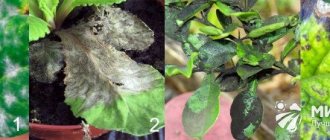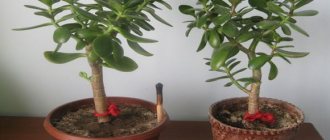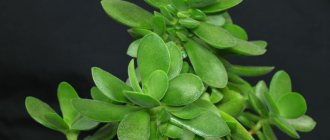Irrigation is carried out with water at room temperature.
For the transplant to be successful, you will need to avoid moving the pot until the cutting is completely rooted.
Crassula diseases are mostly caused by inappropriate care , which in turn leads to deformation of the plant, sunburn, yellowing and shedding of foliage. It is necessary to adhere to the specified recommendations for the maintenance of fatty mushrooms in order to prevent the occurrence of diseases. However, the negative impact of fungal spores or bacteria cannot be ruled out, the elimination of which will require treating the flower with appropriate preparations.
Pests that have settled on a bush are visible to the naked eye or reveal their presence by the appearance of a certain coating. Their elimination is carried out by treating the money tree with a soap solution, increasing the humidity, or washing the bush under running water.
Silvery dots on the leaves and other parts of the Crassula: what is it and why does it appear?
Crassula rarely gets sick, but sometimes gardeners are bothered by the white coating that appears on the leaves and trunk. Diseases in Crassula can appear due to improper care or insect pests.
- Incorrect watering. White spots on the money tree indicate improper watering. The plant does not like excessive moisture. The roots of the succulent may begin to rot, in which case it will be much more difficult to save it (why do the roots rot and what to do in this case?).
- Mealybug. If you notice a white coating on the axils of the leaves or on the roots that looks more like cotton wool, this indicates that a mealybug has settled on your Crassula. This parasite slows down the growth of the plant and bends the shoots. Because of it, the leaves begin to fall.
- Spider mite. The appearance of spider mites is indicated by white-yellow spots on the leaves. If you miss treatment at this stage, this will lead to the appearance of cobwebs and parasites on the plant.
- Fusarium rot. The disease in the money tree is difficult to notice when the trunk and leaves have not lost their elasticity. If you find a white coating, try rubbing it gently with your fingers. If you smell mold, it means the succulent is affected by Fusarium rot.
Crassula treatment: how to get rid of the problem?
If the fat plant is covered with a silvery coating, it is important to take timely measures to save the plant, and what exactly needs to be done is described below.
If watering was incorrect
Crassula needs rare but abundant watering, as it retains moisture. In summer, the plant should be watered 1-2 times a week, in winter – once every two weeks. Water the Crassula with water at room temperature. Pay attention to the location of the plant in your home (office). The succulent loves indirect sunlight.
What to do if you have mealybugs?
A soap solution will help deal with mealybugs. If you find only a white coating in the form of fluff, then treat the plant with cotton swabs. Repeat this procedure several times. If there are parasites on the affected areas, you can fight them with the help of insecticides:
Ventilate the room: Crassula’s immunity will be strong.
If you have spider mites
Spider mites do not like high humidity. You need to give the plant a warm shower, treat it with a soap solution, a solution of garlic or tobacco, cover it with a cap and create a greenhouse. Biological products such as:
After a week, repeat the procedure. Inspect other plants (if present) for harmful residents to prevent them from appearing again.
For fusarium rot
Fungicides cope with fusarium rot: “Fundazol” and “Fungicide”. It is necessary to transplant the succulent into a new pot.
- It is necessary to remove all the old soil, as traces of the disease may remain on it, and inspect the roots.
- If some of them have begun to rot, then they should be removed with sterile scissors.
- Dip healthy roots into a solution of potassium permanganate for a while.
- To make the plant take root faster, soak it in a root formation stimulator.
Despite its unpretentiousness, the money tree is susceptible to diseases. If you notice the disease in time and start fighting it, Crassula can be saved. With proper and competent care, you can extend the life of your plant for a long time.
Money tree diseases
The leaves of the money tree are turning red
Often the leaves of money trees turn red when exposed to direct sunlight. The problem is especially common when growing succulents on the south side of the house. Initially, the color changes at the edges of the leaves, then the red spot spreads over the entire area of the shoots. At the same time, a sluggish, wrinkled and unaesthetic state of the leaves is observed. Moving the pot to partial shade will help save the plant from the inevitable loss of leaves.
Symptoms of Crassula Disease
A red hue on the inside of the leaf indicates the need to check the soil used to grow the money tree. The problem often lies in improper and unstable watering. At a comfortable room temperature and diffused light, the plant is moistened once a week in spring, once every 3 days in summer, and once every 7-10 days in winter and autumn.
Why are the leaves falling off the money tree?
A rare occurrence for the money tree is the shedding of leaves. There are several reasons why the leaves of the fat plant fall off; more often than not, gardeners violate the rules for caring for the crop:
- Exceeding the dosage of fertilizers is also a common mistake among flower growers who are interested in why fat plants drop their leaves (excess mineral salts are especially dangerous).
- Incorrect watering. Many believe that if Crassula prefers to grow in arid Africa, the plant needs to be watered extremely rarely. In summer, a lack of moisture for the money tree is accompanied by a loss of leaf elasticity and rotting of the lower part of the trunk. Excessive moisture and stagnation of water in the soil will cause rotting of the roots and shedding of leaves.
- Burns that cause redness of the crassula in direct sunlight.
- Sudden changes or consistently low room temperatures cause the leaves to fall off.
- You should not water the southern crop with chilled water; the plant will lose its juicy dark green color.
Fungal diseases of Crassula, caused by harmful microorganisms at high humidity and air temperature, are less common. The main signs of a bacterial attack are a white coating, silvery dots, the plant begins to wither and shed leaves.
Yellowed crown of Crassula
Ways to combat infectious diseases:
- Scale insect is a pest in the form of an earring with a waxy shell. Recognized by light brown tubercles on the foliage of the tree. A pest attack provokes gradual yellowing and falling of leaves. The scale insect is afraid of soap solution and insecticides: “Aktara”, “Fitoverm”, “Fufanon”, “Intavir” (the affected areas of the plant should be scorched before treatment).
- Mealybugs cause baldness in the crown of the money tree. The parasite is not easy to detect; the small worm lives in the rhizome and leaf axils. The insect sucks the sap from the living tissues of the plant, causing the death of the money tree. The plant's immunity decreases, Crassula begins to gradually dry out. The surface of the individual is covered with a white coating, similar to cotton wool. In some areas, fluffy tubercles can be seen. When attacked by a parasite, the fallen leaves are burned, the plant is treated three times with an infusion of tobacco or garlic, and a solution of laundry soap. Replant the crop into a new pot, replacing the soil.
- Spider mites (easily identified by light spots on the leaves) are destroyed with Actellik. The plant is first washed in the shower.
- The root mealybug lives in the lower part of the tree and on the roots of the fat plant. Detecting the parasite is not easy. Plant owners notice worms when changing the pot or soil. It is possible to cure the roots of the money tree with insecticides after preliminary washing with running water. The procedure is repeated several times, observing a time period of 7 days.
Reasons for wilting of the fat plant and measures to save it
The fat woman has gained its popularity thanks to its amazing unpretentiousness. But even such a persistent plant can be caused by an inept gardener to develop a serious disease from which it dies. This happens if you regularly and grossly violate the care regime for the crassula. To prevent this, you need to know about possible diseases of the money tree and methods of treating crassula, as well as the reasons why the leaves of the plant crumble and fall off.
Why is the money tree dying?
There are many components to caring for a fat woman. And only because of some of them can Crassula die. There are also factors unrelated to care. Here are the probable reasons why the money tree dies:
- Diseases associated with improper care;
- Damage to Crassula by harmful insects.
Fungal, bacterial and viral infections;
Improper care of the fat woman
Diseases of poor care of the money tree are non-contagious diseases of the plant that it receives due to various external factors. It should be noted:
- Incorrect watering regime;
- Poor lighting;
- Sudden change in temperature;
- No replanting or fertilizing.
Lack of moisture affects the plant gradually; the money tree can be easily restored by correcting the watering regime. When there is a lack of moisture, the money tree's leaves fall off. Often after this it looks bare and it will take a long time to revive the money tree.
Low lighting is unacceptable for Crassula. Its shoots become long and thin, and the leaves of the fat plant are small. Often such shoots break under their own weight, the fat plant does not die, but loses its decorative effect.
It will take a long time to revive the fat woman. Crassula does not like sudden drops in temperature. In a cold draft or under a stream of air from an air conditioner, the plant may shed its leaves.
Timely replanting and feeding are necessary for the rapid growth of the fat plant and maintaining its decorative appearance. Without these procedures, the plant will soon slow down, its new leaves will be small, and its shoots will be lifeless.
Money tree diseases
Crassula is a plant that is very resistant to infections. All possible infectious diseases are divided into groups: bacterial infections and fungal diseases. Bacterial infections affect only very weakened specimens. And this happens extremely rarely.
Affected leaves become covered with red spots of various shapes. Over time, the spots become more and more numerous. The plant is treated with antimicrobial treatments repeatedly, and the affected leaves are removed.
Fungal diseases are very common. They are the result of improper watering and too high air humidity. The affected plant quickly dies, but it can be saved by destroying the fungi and adjusting its care.
Silvery coating on the leaves of Crassula
Sometimes you can see a silvery coating on the leaves of the money tree. This is the beginning of the fungal disease “powdery mildew”. The disease develops well when there is an abundance of moisture in the soil and air.
Soon a white coating appears on the leaves and shoots of the Crassula, and the leaves and branches of the tree gradually die off. Over time, the tree dies. When there is excess moisture, white dots appear on the leaves of the money tree. This is a natural process, but a sign that a mistake was made in caring for the plant.
It is necessary to adjust the watering of the Crassula and ventilate the room to reduce air humidity. Then the white dots will disappear on their own after a while.
Root and stem rot
Root and stem rot are the most common fungal diseases of Crassula. They occur when the plant’s watering regime is violated or moisture stagnates in the soil. Crassula is a succulent.
It needs to be watered abundantly, but between waterings the earthen ball should dry out almost completely. If the soil remains constantly wet, a fungal infection develops in the soil, affecting the roots of the plant. The root system ceases to perform its functions and the plant dies.
Sometimes, after the roots, the plant trunk begins to rot. But stem rot can still develop if the top layer of soil is waterlogged. The tree trunk softens and the plant falls. Treatment for stem rot is impossible. The fat woman can no longer be saved. It is necessary to use all living shoots for cuttings, and destroy the plant that dies.
Crassula pests
Crassula rarely suffers from insect pests. But sometimes a weakened plant is attacked by certain types of harmful insects:
- Spider mite;
- Shchitovka;
- Mealybug.
Spider mites settle on the tops of shoots and young leaves. The tick is difficult to detect due to its small size. But it is easy to notice the web on the underside of the leaf blades. There are also mites that feed on the sap of the plant and leave yellow spots on its leaves.
Scale insects are another dangerous pest. Adult insects are small in size and covered with brownish shells. They sit motionless on leaves and shoots, feeding on sap, or slowly move along tree branches.
White deposits in the leaf axils indicate the presence of another pest - the mealybug. It is dangerous not only because it can damage the plant. Its deposits contribute to the development of sooty fungus on the branches of the Crassula, from which the Crassula also quickly dies.
Problems with houseplant leaves
The unpretentious fat woman rarely dies if not properly cared for. But if you regularly make mistakes when maintaining it, this will affect its appearance. The leaves of a tree are an indicator of the health of the plant.
And if the leaves of a tree take on an unusual and dull appearance, become wrinkled or begin to fall off, this is most likely not a disease, but the consequences of improper care. If the money tree is withering, it can be saved by changing its care.
The most common problems with Crassula leaves that arise due to improper care and ways to solve them:
- The money tree is losing its leaves - most likely, the roots of the plant are cramped in the pot, you should take out the fat plant, inspect the roots and transplant it into a more spacious pot;
- The leaves of the money tree turn yellow and fall off en masse - problems with the roots due to stagnation of water in the pot, the earthen ball should be dried and the watering regime adjusted;
- The leaves wither and become thinner - a problem that occurs when there is insufficient watering and the plant is kept in direct sunlight;
- The leaves of the money tree become smaller - the result of a lack of nutrition in low light; it is necessary to feed the plant and move it to a more illuminated place;
- The appearance of black and brown spots on the leaves of the fat plant - if the spots are dry - these are burns due to keeping the plant in direct sunlight, and wet spots indicate the onset of a fungal infection. In any case, the leaves of the money tree cannot be saved; they gradually die;
- Leaves wither and droop - observed when watering with cold water or when there is excess fertilizer; it is necessary to adjust watering and reduce fertilizing.
How to save a fat woman at home
If problems arise with the fat plant, it is necessary to determine their cause and immediately carry out work to save the plant. The fat woman is very unpretentious, so don’t throw it away. At home, a fat woman can almost always be saved and its beautiful appearance restored. If the money tree dies, you need to do the following:
- Replant into new soil;
- Adjust plant care;
- Treat infectious diseases with appropriate medications;
- Get rid of pests.
Transplanting a plant
If the roots of the money tree have rotted due to stagnation of water or abundant and frequent watering, then it can be saved by replanting it in new soil. This is an opportunity to save the plant from serious infections.
If problems arise with the growth and development of the fat plant, transplantation should not be postponed until spring. This procedure must be carried out immediately, since the disease progresses quickly and the fat woman soon dies. In case of an emergency transplant, the plant is removed from the pot and the old soil is removed from the roots. After this, the root system is examined.
All sections are treated with crushed activated carbon, the plant is dried for 2-3 hours before planting. The fat plant is planted in a new pot with fresh soil. Drainage at the bottom of the pot is required. After planting, the plant is not watered for 2-3 days and placed in partial shade for 1-2 weeks.
Irrigation correction
Crassula is a succulent. It is adapted to absorb a lot of water during rain, and then use this water sparingly during a long dry period. Watering this plant at home should not differ much from natural conditions.
Only with this regime will the plant’s roots function normally. The main mistake in keeping Crassula is abundant and frequent watering. It very soon leads to rotting of the roots, from which it is very difficult to save the plant; it dies.
But you shouldn’t let the soil in the pot dry out for too long. In winter, water in small portions, since at low temperatures the soil dries out slowly and there is a risk of waterlogging. Watering is carried out with warm, settled water.
Lighting is important for the Crassula. It needs bright, diffused light all year round. Direct sun can leave burns on the leaves, and lack of lighting leads to stretching and weakening of the tree shoots.
Treatment of money tree diseases
To treat crassula diseases at home, store-bought medications are used. You cannot use traditional methods of treatment, since the effect of this is extremely low, and it is impossible to save the plant with their help.
In the early stages of the disease, you should try to save the plant by treating it repeatedly with an interval of 7-10 days with antimicrobial agents (Trichopolum, copper sulfate). Before treatment, all affected areas of the plant are removed.
If leaves and shoots are damaged, the above-ground part of the plant is treated. To combat root rot in the early stages, watering with a fungicide solution under the root has a good effect. Diseased leaves and stems must be cut off and destroyed; they cannot be saved. Common fungicides for indoor plants: Trichodermin, Fitosporin, Fundazol.
Pest Control
Crassula pests can be divided into harmful insects and harmful arachnids (mites). Store-bought pesticides will help fight them. You should not fight using folk methods.
These methods do not make it possible to completely destroy pests. They will remain on the plant and will continuously destroy it. At the same time, it is in a depressed state and soon dies.
To destroy harmful insects, insecticide preparations (Aktara, Arrivo) are used. They are used to treat the above-ground parts of plants to destroy adult insects and their larvae.
When destroying scale insects, it is necessary to collect adult insects manually, since they are insensitive to drugs under the shell. Acaricides are used against ticks: Demitan, Neoron. These are narrowly targeted drugs.
The widest group of pest control products are insectoacaricides. These are complex drugs that act on insects and arachnids (Akarin, Actellik). They are easiest to use to save the plant from any types of pests.
How to revive a frozen plant
It happens that the fat woman is forgotten near an open window in winter and it freezes very much. After this, it sheds its leaves, its frostbitten branches turn black and fall off in parts. It seems that the plant is dying. But don't throw it away. Most often, the fat woman can still be saved.
If all the branches are completely damaged, only the trunk remains alive - no problem. New shoots will also grow from the trunk, although the restoration of the Crassula will take much longer.
The roots of the plant may also be frozen. Therefore, the plant is removed from the pot and the root system is examined. All dead parts also need to be cut off; they cannot be saved, and the dead tissue will become a site for the development of a fungal infection.
The sections are treated with activated carbon. After this, the fat plant is planted in new soil. Watering is carried out very carefully until the fat plant begins to grow. The growing plant is watered as usual.
FAQ
Despite its unpretentiousness, the fat plant often dies in the hands of an inept grower. Many succulent lovers have the same problems. They wonder how to save their plant. Here are some common questions gardeners ask and their answers.
Why did the money tree start to fall?
Sometimes in winter, the fat plant may fall out of the pot. This happens because it is kept dry in winter and the loose soil in the pot dries out. And since the fat plant has a powerful crown and a small root system, it can turn over and fall to the floor.
But sometimes a fallen plant breaks into several pieces. It is not possible to save a broken fat woman. But its fragments can be rooted and planted in separate pots. If these cuttings are large enough, then from each you can soon get a beautiful fat plant.
What to do if the fat plant dries up?
Often the fat plant slowly dries out and dies. It can dry out for various reasons, but it cannot be saved. However, this plant is so tenacious that parts of the branches capable of rooting remain on it for a long time.
You can cut large fragments of branches. All of them take root very easily and give rise to young money trees. It is important that all cuttings are taken correctly from living shoots. If there is a piece of diseased or dead tissue near the cut of the cutting, the cutting will not take root and will die.
Preventive measures
Very often, the money tree (crassula) dies due to the lack of basic infection prevention. Here are some necessary preventive measures to save the plant and provide it with the necessary living conditions:
- Regularly checking the soil moisture - do not water the plant if the soil is less than half dry;
- Heat treatment of the soil before planting, which allows you to destroy harmful fungi, microorganisms and pest larvae;
- Treatment of sections with crushed activated carbon when pruning fatwort and carrying out therapeutic measures;
- Ventilate the room in which the fat plant grows to reduce air humidity;
- Regular inspection of the plant for the presence of harmful insects or mites on it in order to begin timely fight against them;
- Adding pieces of charcoal to the soil to prevent root rot.
Why does the Crassula die?
The flower dries up
The succulent begins to dry out and shed its leaves when there is excess soil moisture or the root system fills the entire space of the pot. The plant will be saved by drying the soil and rhizomes and replacing the container with a larger version.
The crown turns pale and crumbles
Probable reasons:
- frequent watering;
- lack of moisture (the plant begins to quickly turn yellow);
- using cold water for irrigation;
- excess fertilizer;
- response to stressful situations.
If the top of the Crassula has faded and began to crumble, you should stop feeding for a month, reduce the amount of moisture or add small portions of water, and let the watering liquid settle in advance.
Crassula froze in winter
Homemade succulent easily copes with short-term frosts down to 0 degrees, but crassula cannot withstand more severe conditions. A frozen tree can be saved if you cut off the dead areas, treat the cut areas with charcoal and continue caring. No additional measures are required.
The shoots are rotting
Brown, rotten areas on the tree are possible due to excessive watering or waterlogged soil. Earthen coma needs to stand dry for 2-3 days. If drying does not give positive results, the gardener can help by rooting a healthy shoot to obtain a young plant.
Fertilizers and biostimulants will provide restoration processes for fatty grass in case of illnesses. Timely watering and maintaining optimal air temperature are important. You also need to remember that the plant may turn red in the open sun.
Caring for a succulent has a positive effect on the health of the flower and prosperity in the home.
Why is there a white coating and sticky spots on my Money Tree?
White spots and plaque on Money Tree (Crassula Ovata) are a common problem and can ruin the appearance of the most beautiful plant. Luckily, identifying the causes and treating this problem is easier than you think.
The main reasons for the appearance of a white coating on the leaves of Crassula can be mold such as powdery mildew, excess salt secretion or insect infestation. Our guide will help restore your flower to health and optimal appearance. Read more about this below.
Preventive measures for the occurrence of points
Prevention plays the most important role. If you provide Crassula with optimal conditions and proper care, white plaque will never appear.
Important for the money tree are:
- Lighting. The plant should receive at least 4 hours of sunlight every day. Otherwise, the flower begins to stretch out greatly, often gets sick and is affected by pests.
- Watering. It is necessary to constantly monitor the condition of the soil. As soon as the soil dries out, moisture is required.
- Temperature. The temperature in the room where the plant is located should be within + 18... + 24˚С. This will prevent the appearance of white plaque on the vegetative organs.
Preventing the problem with proper care
If you see white spots on your Money Tree and can determine the cause, your flower is one step closer to health! But to prevent the problem from recurring, it is important to properly care and maintain your Succulent.
Lighting
Crassula needs at least 4 hours of bright sunlight every day. If this is not ensured, the plant will begin to stretch and become susceptible to pests. Low light also stimulates the growth of powdery mildew. So place your flower on a south-facing windowsill.
Watering
Always make sure the soil surface is dry before watering again. Crassula plants require less moisture than traditional houseplants. In addition, reducing the amount of moisture in the soil interferes with the development and growth of fungi. Proper watering is one of the most difficult and important skills when caring for indoor plants.
Temperature
Make sure you provide enough bright light for your flower, avoid excessive humidity and make sure the room temperature is maintained between 18-24°C. This will avoid the appearance of white coating on the leaves and grow a healthy tree. Make sure that the conditions for keeping the Money Tree match those that suit the flower.
Crassula for runny nose in adults and children: recipes
The antimicrobial and anti-inflammatory properties of Crassula juice are excellent for treating runny nose in children. But it should be done correctly. Like the aloe leaf, the crassula leaf should be wrapped in cling film or plastic and placed in the refrigerator for several hours.
Low temperatures activate cell division in the leaf and increase the concentration of the beneficial substance necessary to eliminate the runny nose. After this, squeeze 2-3 drops of Crassula juice into each sinus three times a day.
Why do the leaves fall off the money tree?
Sometimes a flower begins to have a problem with leaves falling off. The spectacle looks sad, so it is necessary to quickly figure out why the money tree is shedding its leaves in order to stop this process. There may be several reasons:
- Excessive feeding with mineral fertilizers. Excess mineral salts are quite capable of leading to leaf fall.
- Presence of pests.
- Exposure to direct sunlight. Excessive light often causes brown spots to appear on the leaves and cause them to fall off.
- Temperature changes.
- Incorrect watering. Crassula can get sick from both excessive watering and lack of it.
- Watering with too cold water.
- Plant aging.
To stop leaf falling, it is worth identifying the cause and eliminating it.
For example, if there is an excess of fertilizers, the money tree should be transplanted to another soil. Special means help to cope with pests. In case of excessive lighting, the flower is covered with newspapers. If the watering mode is incorrect, it is adjusted in the right direction. The water should be at room temperature. An aging fat woman is rejuvenated by circumcision.
Why does the fat woman get sick and how to deal with it
There are also dangers arising from the activity of fungi or bacteria that love dampness and cold. Plants with weak immunity are especially susceptible to them.
Crassula fungus infection
The most common causes of illness in the fat woman are fungi and bacteria. Their appearance can be provoked by an excess or lack of air or soil moisture, air temperature or lighting.
The most vulnerable period of time for Crassula is winter, when daylight hours are short. In addition, there are constant temperature changes in houses due to the low temperature outside the window in combination with the operation of the heating system.
The fungus attacks plants with weakened immune systems.
Crassula can be affected by wet rot or gray rot, the occurrence of which is provoked by fungi. In this case, brown spots appear on plant tissues, increasing over time and eventually covering the entire plant. It is necessary to transplant Crassula into new soil in time or root healthy cuttings (when the disease is not yet in an advanced stage). Otherwise, the rot will quickly spread throughout the entire bush and the plant will die.
The process of spreading putrefactive lesions can be stopped by sharply reducing watering and increasing ventilation. The affected areas of the bush are cut off, and the wounds are disinfected with potassium permanganate, brilliant green or an alcohol solution. After processing, the sections are powdered with ash or crushed coal.
Crassula infection by bacteria
Identifying a bacterial infection of Crassula is very problematic, since the external symptoms of the disease are practically indistinguishable from fungal ones.
Symptoms of bacterial and fungal diseases are similar
Rot caused by bacteria can be treated with fungicides. A series of antibiotic foliar treatments are then carried out using penicillin or gentamicin. Penicillin does not have a toxic effect on plants even in severe doses. Therefore, you don’t have to be afraid of killing the fat woman, especially since injections will be the most effective help for it, and it’s better to turn to specialists with this issue.
What to do if the money tree has soft leaves?
Typically, a plant experiences a similar disease if it is watered too often.
Inexperienced gardeners believe that Crassula needs water immediately after the soil dries. However, in warm weather it requires watering once a week, and in winter - only once a month. If the leaves become soft, the flower can be revived. The young fat plant is taken out of the pot, the roots are carefully cleaned with a knife, placed in a glass of water, and only then transplanted into new soil. It is not recommended to remove an adult tree from the pot. It is enough to remove the wet substrate, replacing it with dry soil. Watering stops completely.
The problem is also observed in the presence of pests. In this case, special preparations and treating the foliage with a sponge and soap will help.
Crassula does not grow.
Sometimes the absence of visible signs of growth is associated with the plant's dormant period, for example, in the winter in a cool room. However, there are also other reasons - lack of lighting or nutrients, as well as poor watering.
If your Crassula stands far from daylight, this is most likely the reason for the lack of growth.
The solution to the problem is very same as in the previous case - changing the location or additional lighting.
If the Money Tree stands in a well-lit place, but still does not grow, think about how often you water it, perhaps you forgot about it and the plant did not receive moisture for the second month. How long have you been fertilizing the soil?
The solution to the problem is to water the plant and then apply fertilizer (use a dosage 2 times less than indicated on the package).
How to feed the money tree at home?
In its natural habitat, the fat woman is accustomed to receiving food as a result of a desperate struggle for survival, so she is fed quite rarely. In spring and summer, the procedure is carried out once a month, and in autumn and winter - once every two months. Beginning flower growers prefer to buy cactus solution in florist shops for this purpose, using it in accordance with the instructions. Moreover, in cold weather the solution is made twice as weak so as not to harm the plant.
Crassula requires the following nutrients:
- Potassium elements , the deficiency of which leads to the unnatural color of the money tree and the appearance of yellow spots. If there is too much potassium in the soil, the root system is destroyed.
- Phosphorus , which ensures normal growth of the fat plant and the appearance of healthy shoots. Its lack causes darkening of the foliage.
- Nitrogen . Excess and deficiency of the substance have a bad effect on the development of Crassula.
- Calcium , which plays a key role in the development of the flower skeleton and helps to establish water balance.
Usually, a universal fertilizer is used to feed the plant, but calcium can also be added using a prepared composition from egg shells, or an infusion from it.
To do this, the shells are washed, dried, ground into a fine powder, and then added to the money tree pot. It is recommended to place such fertilizer at the bottom of the container for the fat plant when replanting for drainage. The shell layer will facilitate the flow of air to the root system and prevent waterlogging of the soil.
The infusion is prepared as follows: place ten shells in a liter jar, pour boiling water over them, and leave for two weeks in a place where light does not penetrate. The resulting liquid is used to water Crassula.
It is recommended to fertilize the flower in the evening, but not immediately after planting the young plant. You should also make sure that the plant does not have root rot.
The soil in the pot should be moist before the procedure. The next day, the tree is sprayed with warm water.
Improper care
First of all, you should consider the negative factors that relate to errors in plant maintenance. It is they that in most cases lead to a deterioration in the appearance of the fat plant, falling or blackening of foliage, disproportionate growth, etc.
Yellowing and falling leaves
Very often, owners of fat cats face this problem. In this case, to eliminate the problem, it is important to adhere to the following watering rules:
- Moisten the soil only with warm water, previously filtered or settled. When watering with cold water, the difference in air and soil temperatures can adversely affect the condition of the plant.
- Avoid excessive waterlogging of the soil during the cold season. This situation leads to rotting of the roots, as well as the formation of fungus.
- Dying of leaves can be caused by drying out of the soil in summer. If its top layer becomes too hard, you should immediately water the flower.
- prolonged exposure to direct sun;
- lack of sufficient fresh air flow;
- lack of nutrients in the soil.
Stretching the stem
Disproportional development of the bush often occurs due to insufficient lighting. If watering standards are observed, but there is a lack of sunlight, the fat plant stretches the stems, trying to get to the sun. As a result, there is insufficient development of leaves and branches, despite their large growth.
If the money tree is sick for this reason, just put it closer to the window. However, it is important to avoid excessive exposure to sunlight to prevent burns.
In some cases, the stems become elongated due to the normal development of the crassula. To prevent them from falling on their side, you should transplant the flower into a wide pot. Its root system grows in a horizontal plane, so transplanting it into a deeper container will not give the expected results.
soft leaves
If the foliage of the money tree has lost its elasticity and softened, then this could be caused by excessive watering, lack of lighting or inappropriate room temperature. The process of restoring the flower should be started immediately, otherwise it will soon die completely.
The plant is removed from the pot along with a lump of earth, then the soil is removed. The root system is being inspected.
Note!
If rotting or moldy areas are found, they are cut off. Next, the roots are washed under a stream of water at room temperature, the sections are treated with charcoal or activated carbon tablets crushed to powder.
All that remains is to plant the fat plant in a pot using a new substrate. For the first watering, carbendazim is used. The plant is placed in a bright place, but without direct sunlight.
There is no point in saving Crassula if rotting of the roots occurs at the base, or they are soft and dark along their entire length.
Leaves turn black
If the leaves of the money tree become covered with black spots, this is an indication of sunburn. The unhealthy area appears strictly at the point where the light ray hits and does not spread further. The blackened leaf can be removed, and care must also be taken to prevent direct sunlight from hitting the flower in the future.
However, there is another reason for the formation of black spots on the leaves of the fat plant - fungal infection. The fight against this disease consists of using the drug Fitosporin-M. It is diluted in a twice as large volume of water, after which it is thoroughly stirred and diluted again with water (the procedure will be described in more detail in the instructions for the drug). The foliage is sprayed with the resulting solution, and after a while the operation is repeated.
Lack of growth, drying out
Crassula will stop growing if its roots become crowded in the pot. You should choose a container that is slightly larger in volume. The new pot should be wider and only slightly higher, since the roots prefer to grow horizontally. It is better to transplant a flower in the spring, but if it is infected with fungus or other diseases, the procedure cannot be postponed.
A slowdown in development can also occur during winter dormancy. This is a normal phenomenon and does not require any measures to be taken.
Another reason could be a lack of nutrients in the soil or poor lighting. It is necessary to purchase complex fertilizers in a specialized store and use them in accordance with the instructions.
Important!
Drying foliage indicates an incorrect watering regime. Excessive or insufficient amounts of moisture may be added to the root. In summer, watering is carried out more often, after the top layer of soil dries, in winter - less often.
White dots on leaves
The money tree can be overly saturated with moisture received not only from the ground, but also from the air. As a result, the plant has to open spores on the leaf blades to get rid of excess water.
The appearance of white spots does not promise any particular danger, however, you should pay attention to the frequency of watering and, if possible, reduce the humidity in the room (for example, increase the temperature with a heater if we are talking about the winter period).
Reddening of foliage
A change in leaf color from green to pale or even bright red can occur for three reasons:
Treatment will be appropriate:
- Provide the plant with shade.
- Ventilate the room regularly.
- Fertilize with nutrients. The need for this action is also indicated by wilting leaves.
White coating on the leaves of the Crassula
Although Crassula rarely gets sick, sometimes owners may notice the appearance of a white coating in the axils of the leaves. It looks like small pieces of cotton wool. This phenomenon indicates that a parasite has settled on the flower. When plaque has a moldy smell, it means fungus has appeared.
You can get rid of it if you treat the plant with phytosporin or foundationazole. When there is no smell, treatment is carried out using phytoverm or actar. If harmful mealybugs are found on a money tree, they are immediately destroyed by wiping the surface of the fat plant with a soap solution. A sponge or brush is used for this. Insecticides also help in the fight against scale insects. But they should be used if the soap solution does not have the desired effect.
Diseases are the cause of the appearance of white plaque
All types of Crassula have good immunity and are perfectly adapted to growing at home. Physiological diseases are associated mainly with improper agricultural practices, especially excessive watering.
Normal waterlogging of the soil will not cause the vegetative organs to become covered with white spots or plaque. They are more likely to darken or turn yellow, and with prolonged drought they will wrinkle and dry out.
A clearly visible white coating appears on the leaves or trunk due to infectious diseases. If a pot of Crassula is taken outside in the summer, one should not be surprised, but pathogens enter the apartment:
- when contaminated garden soil is taken for planting;
- when using a dirty tool to care for the fatty;
- from the fur of pets walking on the street;
- on the unwashed hands of owners who worked in the garden or vegetable garden and decided to “communicate” with a houseplant.
Powdery mildew
An infectious disease caused by Erysiphales fungi. External signs - the leaves are covered with an uneven white coating, similar to flour. It clogs the stomata, interferes with photosynthesis, and if the owners do nothing, the fat woman may die. Easy to diagnose.
The occurrence and development of infection is facilitated by:
- dry soil with high air humidity;
- temperature changes;
- crowding of plants;
- lack of ventilation.
In the initial stages, white plaque can be washed off with green or laundry soap. Treating an advanced disease is a little more difficult - you will have to treat it with chemicals.
It is not recommended to use copper-containing preparations for treatment at home. It is better to spray the fat plant with a solution of Fundazol - it is almost safe for humans and helps get rid of downy and powdery mildew.
Fusarium
The Fusarium mushroom is much more dangerous than the previous one; it affects the vascular system. It can appear on Crassula from garden soil, or when the pathogen gets into the wound. The latter is caused by contaminated tools or unwashed hands.
If the infection has entered the Crassula through the soil, the root is the first to suffer and rot. The flower begins to fade. When the disease enters its final stage, the base of the trunk is covered with a ring of white or pinkish mold.
When injured vegetative organs of the Crassula are infected, plaque may first appear on the trunk or leaves. Provoking factors:
- temperature above 20 but below 34° C;
- high humidity;
- acidic soil;
- injuries of vegetative organs;
- the room is not ventilated;
- unsanitary conditions;
- substrate is too dense;
- temperature changes.
The fight against fusarium on Crassula is possible only in the initial stage. The flower is treated with a systemic fungicide, for example, Fundazol, the solution is prepared and the frequency is according to the instructions. Then they are sprayed twice with biological products - Trichodermin or Fitosporin.
If the disease has progressed far, it is easier to throw away the fat plant along with the pot and soil than to treat it. When mold has appeared, it is better not to even take cuttings for rooting - the fungus attacks the vascular system and quickly spreads to all parts of the plant.
Money tree pests
Crassula has no specific pests. On it you can see insects common to all indoor plants:
It is quite difficult to remove spider mites. Its presence is indicated by yellow spots on the foliage of the flower. If the initial stage of the disease is missed, then cobwebs and the pests themselves appear between the leaves. They quickly adapt to insecticides, so it is advisable to alternate special preparations. The treatment should be combined with washing the plant with soapy water, infusion of garlic or tobacco. It is recommended to wipe all nearby surfaces with the solution to destroy insect eggs.
It is impossible to notice the scale insect at an early stage of its appearance. Crassula owners know about the damage when they see red, brown and yellow spots on the leaves. The pest is extremely dangerous, so the actions of flower growers must be prompt. It is necessary to smear the insects with kerosene, then manually remove them from the fat plant. Next, the wood is treated with a solution of soap or tobacco. Then it is washed with a swab dipped in clean water. Finally, the use of an insecticidal drug is required.
Mealybug causes flower growth to slow down, shoots to bend, and leaves to fall off. This pest is recognized by white deposits on the leaf axils. If the fight is not started on time, sooty fungi develop.
After treatment, the Crassula should be transplanted into another pot, or the existing container should be disinfected and the soil replaced. Care remains the same.
Thus, although the money tree is hardy and unpretentious, sometimes it is also susceptible to various diseases and pests. To prevent the plant from dying, you should start the fight against the ailments of the fat plant in time. If you monitor the condition of the flower and properly care for it, it can live for many decades.
Video about how to properly care for a money tree and protect it from diseases and pests:
Pests
In addition to Crassula diseases, pests also have a negative impact, photos of which will be presented below. These include spider mites, scale insects, mealybugs and rootbugs. The method of combating each type of insect is different and therefore requires separate consideration.
Shchitovka
This pest is quite large in size, so it is clearly visible to the naked eye. Females remain motionless, they are attached to a stem or leaf, covering their body with some kind of shield. The scale insect has a light brown or brown color.
The first step in the fight against the pest is its manual removal from the surface of the fat plant. Next, treatment is carried out with a soap solution or a commercial preparation called Fitoverm. To consolidate the result, spraying is repeated after a few weeks.
Spider mite
Unlike scale insects, Crassula is practically invisible on the surface. The appearance of a tick is determined only by the corresponding sign - a silvery coating on the money tree, which is actually a very thin cobweb covering its habitat. The pest itself looks like a gray or red dot continuously moving around the plant.
Along with the cobweb, a change in the appearance of the leaf plate occurs. It becomes covered with brown spots, turns yellow and falls off over time. A simple method of eliminating the mite is to spray the crassula and then wrap the pot in a plastic bag. This will sharply raise the humidity level, and in such conditions the pest does not live long.
Soap solution or preparations Apollo, Actellik, Fitoverm are also effective in removing insects.
Mealybug
The insect quite often attacks Crassula. Its habitat is the axils of the leaves, in which the juice is sucked and plant tissue is eaten. As a result, the immunity of the fat plant weakens, accompanied by the fall of leaves. Externally, the pest’s activity manifests itself as a powdery discharge resembling cotton wool.
